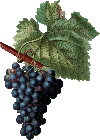Goal of Conservation Biological Control Research
The goal of our research project is to scale-up agroecological
approaches that break vineyard monoculture structures with cover crops
and/or hedgerows and corridors, enhancing biological control (Altieri
et al, 2005). We have been repeatedly approached by wine grape growers
to assist them in re-designing their vineyards to manage insect pests
ecologically. This demand stems from the fact that despite the use of
Integrated Pest Management (IPM) -- an ecosystem-based strategy that
focuses on long-term prevention of pests or their damage through a
combination of techniques such as biological control, habitat
manipulation, modification of cultural practices, and use of resistant
varieties -- many vineyards continue to experience high levels of
pest pressure, an expected trend in monocultures that lack functional
biodiversity (Gurr et al, 2004).
This project is unique in its participatory nature.
Farmers are actively involved in the implementation of the designs as
well as
the monitoring, allowing the testing of a suite of agroecological
strategies in several environments. At each participating vineyard, a 1
acre experimental plot is established to assess the effectiveness of
several designs on soil quality indicators and populations of insect
pests and natural enemies. Strategies to enhance plant biodiversity
include: (a) summer cover crops -- Common Buckwheat between vine rows
and Sweet Alyssum under the drip line between vine plants and; (b)
enriched hedgerows surrounding the vineyards. Diversification will be
complemented with organic soil fertilization treatments to enhance
organic matter content and soil fauna. We expect grapes grown in soils
with high organic matter and active soil biology to exhibit lower
abundance of insect pests (Altieri and Nicholls, 2003). Summer cover
crops effects on natural enemies and pest populations, as well as
influence of selectively planted hedgerows on foliage and soil fauna
are being assessed using well tested methods (Nicholls et al, 2000,
2001; Daane and Costello, 1998). Effects of soil fertility management
treatments on soil invertebrate fauna considered to be sensitive
indicators of soil health are being measured using known monitoring
techniques (Anderson and Ingram, 1993).
Agroecological Participatory Research
All farmers
involved in the project practice organic
agriculture
or follow IPM guidelines, but still rely on mono-cropping
dependent on external inputs. Farmers are motivated to move beyond
input dependence and want to establish biodiverse designs. We will
tailor site specific system designs for each farmer allowing them to
compare trends between experimental plots and their current management
systems. Farmers will be able to interpret the ecological processes and
interactions that underline such observed processes. As farmers become
increasingly confident on the new practices they will
progressively increase the area under agroecological
management.
Understanding how organic fertilization improves plant health
may
lead to new ways to integrate pest and soil
fertility
management promoting synergies between cover crops, soil
invertebrate bioindicators, natural enemies and overall vineyard
health. Conversion to agroecological management will enhance farmers’
income
by opening new market opportunities and attracting a more specialized
type of agroecotoursim. The ecological principles underlying successful
designs can be scaled-up to reach hundreds of other producers,
facilitating the transition of California’s wine regions to greater
ecological and social sustainability.
Outreach
Participating growers play a key role in determining cover
cropping and organic fertilization practices to be used in each
experimental plot, and also in defining plant composition and location
of hedgerows. Managers and a team of farmworkers
collaborate in the monitoring of insect populations, soil and
crop health parameters. Our group conducts several training sessions
(in Spanish) for a group of farm laborers that are becoming crucial
monitoring scouts. Producers also have a key role during field days as
disseminators of the best practices among other farmers in the region.
We expect producers to have a major input into the written materials
produced so that they are relevant and farmer friendly educational
tools.

